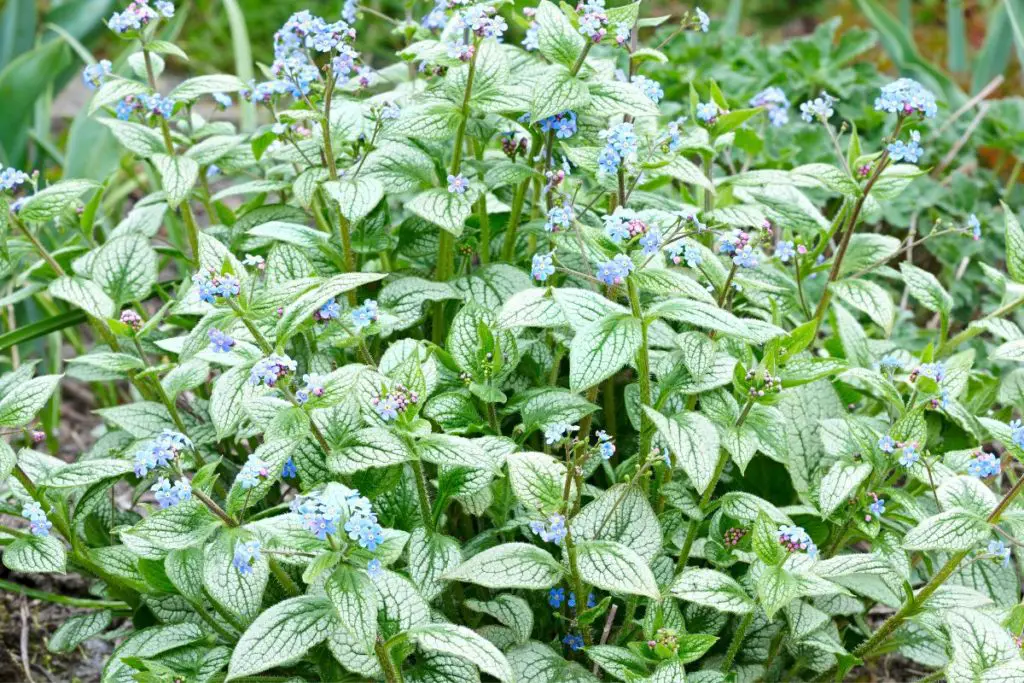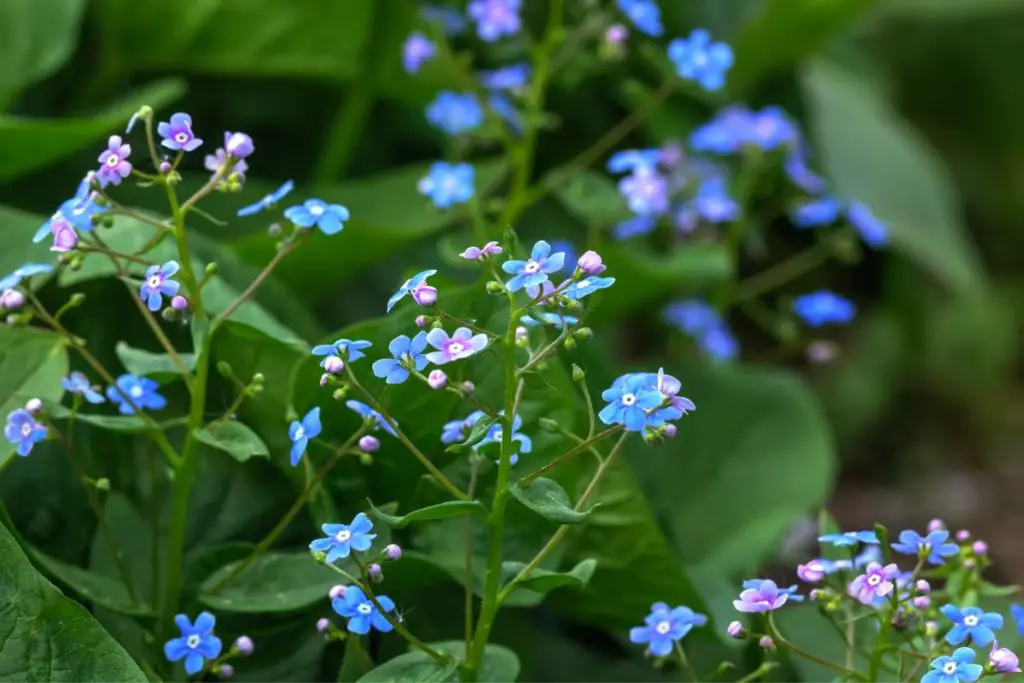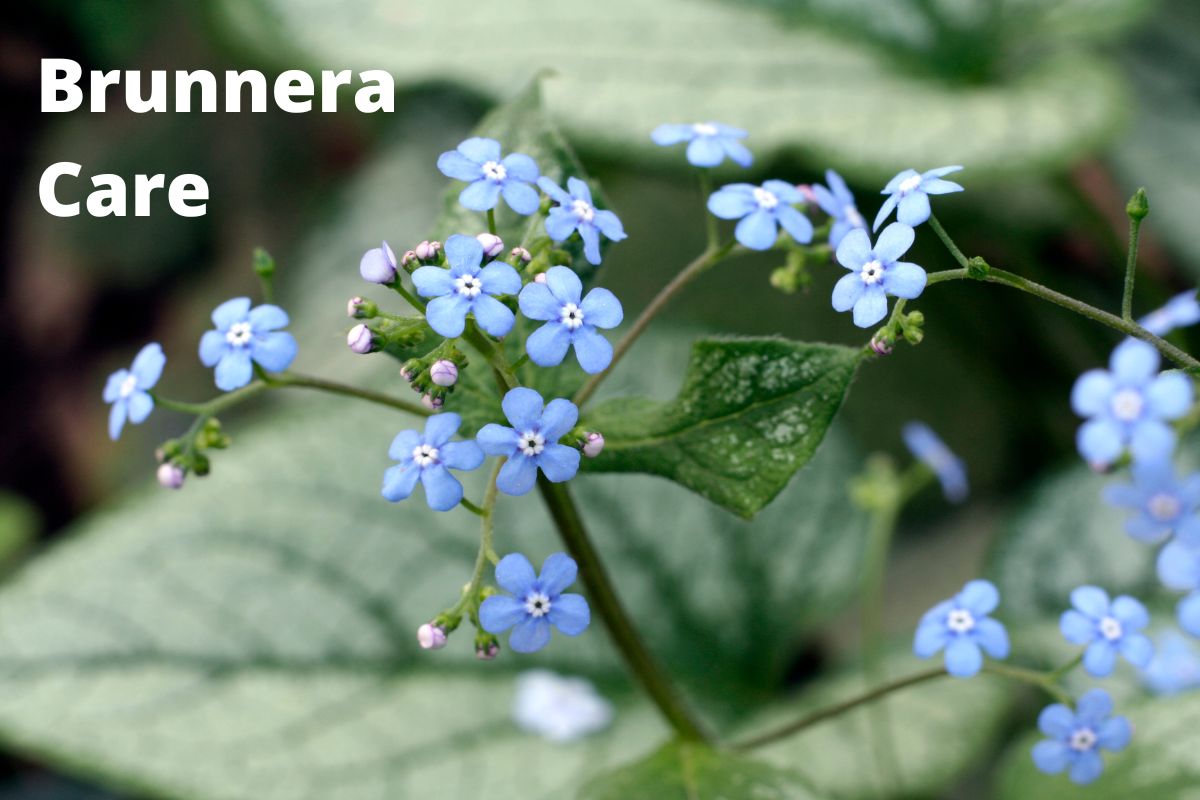Brunnera macrophylla, also known as Jack frost, is another one of those great perennials that add value to any garden.
The dark green, heart-shaped leaves have a silvery white color except on the veins and the margins. This plant offers very interesting foliage with seemingly reverse variegation in combination with beautiful flowers.
Table of Contents
Caring for Brunnera
Brunnera prefers morning sun and afternoon shade. Keep the soil watered and consistently moist. Choose a location that drains well so as not to leave standing water. Brunnera is a great substitute for hostas and other perennial flowers.
Brunneras are in the family of Boraginaceae. The best-known species of Brunnera are the Siberian bugloss. Bugloss comes from Greek, and it means ox tongue.
There are many different cultivars and different names that are derived from the Siberian bugloss, like sea heart, false forget-me-not, and heart leaf.
Brunnera Growing Zone
Brunneras are cold hardy in zones 3-8. They are a remnant of the Pleistocene era. Brunnera used to be restricted to the humid forest habitats of Pleistocene refugial areas, and has now spread all over the world.
Brunneras are cultivars of the plant commonly known as Siberian bugloss. This plant is native to Eastern Europe, including Siberia, and Northwest Asia. Source.
Brunnera Care Shade or Sun?
These beautiful plants are shade-loving perennials. For this reason, an east-facing area against the house, or a fence, is a nice spot for them. Also, a woodland garden, underneath a mountain laurel or a big deciduous tree is a good place to plant brunnera.
Try to plant them where they can get 3-6 hours of dappled sunlight and be shaded the rest of the day.
I have Brunnera in several areas around my home and have found that in the locations that receive more sun, the leaves will get burn spots on them. However, those plants will be up and in full bloom, with a lot of foliage in early March. Once I cut the burned leaves back, they still look full and beautiful.
Ones that I have in dappled shade for a good part of the day are doing well and have a lot of nice leaves but are just starting to put on blooms at this same time of year.
Others that are in full shade are just now starting to emerge from the ground and it may be another month before they look as good as the others.

Watering Your Brunnera
Brunneras are shade-loving and water-loving plants. Pay particular attention to the moisture content of your soil if you live in an area with long, hot, dry summers. Although, I have not noticed my brunneras feeling the effects of the heat unless the soil gets very dry.
If you live in Zone 8 as I do, you may want to water these areas on the hottest days. Despite the rhizomatous root system, these plants are fairly slow growing and do not seem to be invasive at all. Make sure you water your newly planted brunnera well.
Soil Requirement
Brunnera prefers organically rich, well-draining, loamy soil. That being said, they are tolerant to different kinds of soil conditions. For example, if you have soil that contains a lot of clay they will still do well in most cases. This is one of the reasons that brunnera care is pretty easy.
Just make sure that your soil remains moist. They prefer a moderate pH range, neutral to slightly alkaline. Brunnera soil requirements aren’t that difficult to maintain, however, it’s important not to miss any steps.
Fertilizing
It is not necessary to fertilize brunnera if you have rich soil. It is a good idea when planting brunnera, to work in some organic matter like compost to the soil. In the early spring, I use a 4-3-4 fertilizer with nitrogen, phosphorus, and potassium, respectively, with all my perennials.
As with other potted perennials, you can use a liquid bloom fertilizer in the spring and a liquid grow in the fall months. Whether in the ground or in pots though, it is not absolutely necessary to fertilize these plants.
Pruning
These wonderful perennials are easy to care for, but they do require a little bit of maintenance.
Make sure not to remove the dead foliage in the fall as the leaves help protect the plant over the winter. Instead, remove the old foliage in the spring when the new leaves begin to emerge.
In late spring, and throughout the summer months, you want to clean up the old flower stems as the flowers start to decline. Just cut the entire flower stem back to the base.
The leaves on the flower stems are slightly smaller, and will be green, versus the silvery look of the foliage. Follow the stem to the ground and cut it all the way back.
You’ll be left with these big, beautiful, bold leaves that will add some really great color and interest to your garden, through the rest of the summer months and possibly well into the winter. This plant is semi-evergreen so it will disappear for a while. But don’t worry, it will come back next spring, big and beautiful as ever.

Pests and Disease
This hardy perennial has been proven as a reliable and beautiful perennial for shade gardens.
There are, however, some potential problems that you need to watch for. While these plants love moist, rich, well-draining soil, be careful not to overwater. This can lead to crown and root rot. Roots should be tan to white in color.
Commercial growers will often treat these plants with a fungicide drench as a preventative measure because fungal diseases are difficult to treat.
Thielaviopsis, Phytophthora, and Fusarium are potential issues with brunnera and can manifest themselves as small black spots of necrosis on the foliage.
Because of the coarse texture of the leaves, they are not bothered by most slugs. Although, slugs and aphids can be an issue if they are prevalent in your garden.
There are several methods available to treat both slugs and aphids. One of the best treatment methods is the use of Diatomaceous earth. Source.
See our ultimate guide for Brunnera
Related Questions
Do you cut back brunnera?
Towards the end of the growing season and after your brunneras have flowered, you’ll want to remove the old flower stems all the way to the base. Do not cut back the foliage in the fall or winter because the old foliage protects the crown of the plant over winter. Wait until the beginning of spring, after the last freeze.
Will brunnera spread?
Brunnera is a rhizomatous perennial that is easily divided in the fall. The creeping rhizomes spread slowly and grow 2-3 feet wide. Often used as ground cover or along streams and ponds as a border where shaded. By following our brunnera care advice, you should be able to maintain this plant.

